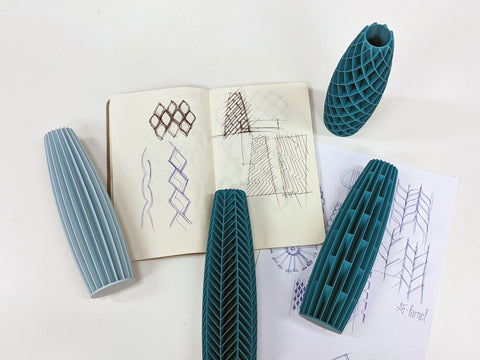
Materials for 3D printing and 3D printing Technologies
There are tons of materials for 3D printing, and the best one depends on what you’re making or rather what technology do you use. Directly in my studio I use FDM/FFF 3d printing technology, however, I do use other 3D print tech in collaborations. Here’s a breakdown of the most common ones across different 3D printing technologies:
FDM (Fused Deposition Modeling) Materials
These are thermoplastics that come as filaments or pellets.
- PLA (Polylactic Acid) – Biodegradable, easy to print, not very heat-resistant.
- rPLA – Recycled version of PLA featuring smaller range of colors.
- ABS (Acrylonitrile Butadiene Styrene) – Stronger than PLA, heat-resistant, but warps easily.
- PETG (Polyethylene Terephthalate Glycol) – Strong, impact-resistant, food-safe, slightly flexible.
- rPETG – Recycled version of PETG - featuring small range of colors
- TPU/TPE (Thermoplastic Polyurethane/Elastomer) – Flexible, rubber-like, great for gaskets or wearables.
- Nylon (Polyamide) – Tough, abrasion-resistant, but absorbs moisture.
- Polycarbonate (PC) – Extremely strong, heat-resistant, but tricky to print.
- Carbon Fiber Infused (CF-PLA, CF-Nylon, etc.) – Stiff, lightweight, but abrasive to nozzles.
SLA/DLP (Resin-Based) Materials
These are liquid photopolymers cured by UV light.
- Standard Resin – High detail but brittle.
- Tough/Engineering Resin – More impact-resistant, mimics ABS-like properties.
- Flexible Resin – Rubber-like properties.
- High-Temperature Resin – Can withstand high heat, good for tooling.
- Castable Resin – Burns away cleanly, used for jewelry or dental applications.
- Biocompatible Resin – Safe for medical and dental applications.
SLS/MJF (Powder-Based) Materials
These use powdered materials fused by lasers or heat.
- Nylon (PA11, PA12, PA6, etc.) – Durable, strong, great for functional parts.
- TPU (Flexible powder) – Used for soft, flexible parts like shoe midsoles.
- Alumide (Nylon + Aluminum powder) – Stiffer than pure nylon, slightly metallic.
- Metal Powders (Stainless Steel, Titanium, Aluminum, etc.) – Used in metal 3D printing.
Metal 3D Printing Materials
For DMLS, SLM, and Binder Jetting.
- Stainless Steel – Strong, corrosion-resistant.
- Titanium – Lightweight, strong, biocompatible.
- Aluminum – Lightweight, good thermal conductivity.
- Inconel – High-temperature and corrosion-resistant, used in aerospace.
- Copper – Excellent thermal and electrical conductivity.
Binder Jetting Materials
1. Metals (Used in combination with sintering or infiltration)
- Stainless Steel (316L, 17-4PH, etc.) – Strong, corrosion-resistant, and commonly used in industrial applications.
- Inconel – High heat and corrosion resistance, ideal for aerospace and high-temperature environments.
- Titanium – Lightweight, strong, and biocompatible, used in aerospace and medical applications.
- Copper & Bronze – High thermal and electrical conductivity, great for heat exchangers and electronics.
- Tool Steels (M2, H13, etc.) – Used for making strong tooling and dies.
2. Sand & Silica-Based Materials (Used for molds and casting)
- Silica Sand – Used to create molds and cores for metal casting, allowing for highly complex designs.
- Ceramic-Based Sands – For high-temperature-resistant molds used in industrial casting.
3. Ceramics (For industrial and artistic applications)
- Alumina (Al₂O₃) – High-temperature resistance, used for electronics and industrial components.
- Silicon Carbide (SiC) – High hardness and thermal resistance, used in aerospace and automotive.
- Zirconia (ZrO₂) – Tough and wear-resistant, often used in medical implants.
4. Polymers & Composites
- Gypsum-Based Powders – Used in full-color 3D printing, common for architectural models and figurines.
- PMMA (Polymethyl Methacrylate, aka Acrylic) – Used in lost-wax casting applications.
